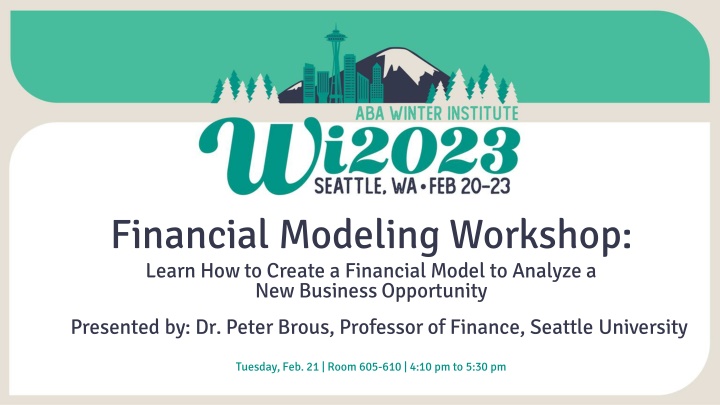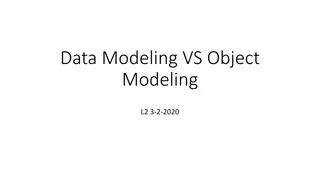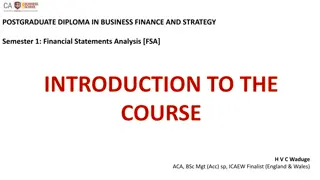Financial Modeling Workshop: Analyzing New Business Opportunities
Workshop with Dr. Peter Brous on creating financial models for investment decisions involving cost/benefit analysis, collecting relevant data, and understanding investor objectives. Learn about estimating costs, using benchmarking reports like Abacus, and conducting examples like opening a bookstore.
Download Presentation

Please find below an Image/Link to download the presentation.
The content on the website is provided AS IS for your information and personal use only. It may not be sold, licensed, or shared on other websites without obtaining consent from the author.If you encounter any issues during the download, it is possible that the publisher has removed the file from their server.
You are allowed to download the files provided on this website for personal or commercial use, subject to the condition that they are used lawfully. All files are the property of their respective owners.
The content on the website is provided AS IS for your information and personal use only. It may not be sold, licensed, or shared on other websites without obtaining consent from the author.
E N D
Presentation Transcript
Financial Modeling Workshop: Learn How to Create a Financial Model to Analyze a New Business Opportunity Presented by: Dr. Peter Brous, Professor of Finance, Seattle University Tuesday, Feb. 21 | Room 605-610 | 4:10 pm to 5:30 pm
Analyzing New Business Opportunities Best Practices Suggest Applying Cost/Benefit Analysis: 1. Identify a New Business Opportunity 2. Collect/Estimate Relevant Data (Costs and Benefits) 3. Analyze the Relevant Data (Apply Cost/Benefit Analysis and Sensitivity Analysis) 4. Make the Investment Decision
Make the Investment Decision The Investor s Objective/Goal of the Investment is Key to the Decision to Invest. Objective/Goal Could Include One or More of the Following: Financial Value Impact (Cost/Benefit Analysis) Social Value Impact Personal Value Impact
Collect/Estimate the Relevant Data (Costs and Benefits) Costs are the Upfront Costs Necessary to Start a New Business Opportunity such as: Build Out Cost (Renovations Necessary), New Equipment, First/Last Month s Rent, Working Capital (Cash and Inventory), etc. Benefits are the Impact on After-Tax Operating Profits (Increased Annual Revenues Increased Annual Costs) Abacus: Financial Benchmarking Report Provides Useful Data to Estimate Costs and Benefits
Abacus: Financial Benchmarking Report: Key Data for Forecasting Future Revenue A Simple Approach to Forecasting Revenue is to Multiply the Store s Useful Square Feet by the Expected Sales per Square Feet. Based on the Data Provided on Page 31 of the Abacus, Average Sales per Square Feet in 2021 was $322, So If Your Store is 3,000 Square Feet then the Forecasted Sales = $322 * 3,000 = $966,000.
Abacus: Financial Benchmarking Report: Key Data for Forecasting Future Expenses A Simple Approach to Forecasting Expenses is to Multiply the Expense as a % of Sales by Forecasted Sales. Based on the Data Provided on Page 24 of the Abacus, Average Expenses per Sales in 2021 are Provided. For Example, Cost of Goods Sold as a % of Sales was 54.5%, So If Forecasted Sales is $966,000, Forecasted Cost of Goods Sold = 54.5% * $966,000 = $526,470.
Real World Example: Cost/Benefit Analysis for Opening A New Bookstore I Was Provided A Bookstore Owner s Forecasts for the Upfront Costs and the Future Benefits (Operating Profit) for the First Three Years of Operations. Based on These Forecasts, I Want to Demonstrate How to Apply Cost/Benefit Analysis and Sensitivity Analysis to Determine the Expected Financial Impact of This Business Opportunity.
A Real-World Example: Estimated Upfront or Startup Costs for a New Bookstore:
A Real-World Example: Assumptions Used to Estimating Benefits (Operating Profits) for a New Bookstore:
Cost/Benefit Analysis: Key Performance Measures 1. Net Present Value (NPV) NPV = PV of Benefits PV of Costs NPV Measures the Expected Wealth Created/Destroyed 2. Internal Rate of Return (IRR) IRR Equals the Expected Annual Rate of Return Is the Expected IRR > Required Return?
Implication of Cost/Benefit Analysis for New Bookstore Based on our assumptions, the expected NPV is $18,708 suggesting that the benefits are expected to be greater than the costs and the investment is expected to be value enhancing. Additionally, the expected rate of return or the IRR is 11.39%/year, since the expected rate of return is greater than the required rate of return (10%) then this investment is expected to earn abnormally high returns and this investment is expected to be value enhancing. How certain are we that this is a value enhancing investment?
Risk Assessment How Certain Are We That This is a Value Enhancing Investment? What If We Do Not Operate the Store for the Full 10 Years? What If Our Revenue Growth is Not as Fast as We Assumed? What If Our Operating Margins are Not as Strong as Assumed?
Implication of Risk Assessment Based on the Investment s Horizon Results: If we assume the bookstore will be in operations for only 8 years instead of the full 10 years, the expected NPV became a -$17,501 and the IRR is expected to equal 7.8% both suggesting this new bookstore would be a value destroying investment. These results suggest that a small change in the investment s horizon (from 10 to 8 years) the expected benefits are no longer expected to be greater than the expected upfront costs. Implication: This is a Risky Investment and is Not Clearly a Value Enhancing Investment.
What if Revenue Growth is not as Strong as we Assumed? Implication: This Appears to be a Low-Risk Investment as the Outcome is Not Very Sensitive to Changes in Revenue Growth.
What if our Operating Margins are not as Strong as Assumed? Implication: This Appears to be a High-Risk Investment as the Outcome is Very Sensitive to Changes in Operating Margin.
New Bookstore Example: Making A Decision Based on the Sensitivity Analysis Regarding the Forecast Horizon (10 Years) and the Forecasted Operating Margin (10.5%), it Appears that this is An Extremely Risky Investment that May Not be Value Enhancing. Therefore, Based on the Financial Value Impact, I Would Not Recommend Investing. However, If the Investors Believes this Investment will Increase Social or Personal Value then Investing Might Be A Good Decision.
THANK YOU! If You Have Any Questions or Want Help With Your Analyses Feel Free to Contact Me At: pbrous@seattleu.edu























